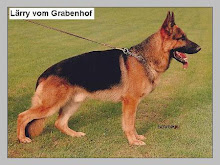It is vital for you to understand that your dog views all his interactions with other dogs, with you, and even with other animals in your household in the "pack" context. When a puppy is born, the first pack leader is his or her mother. From birth, puppies learn how to be cooperative members of a pack-oriented society. At about three or four months after they're weaned, they fall into the regular pack structure and take their cues from the pack leader, not their mother. In packs of wolves and wild dogs, the leader is often a male because the hormone testosterone - present in male puppies from the time they are very small - seems to be a cue to dominance behaviors.
Most dogs, like most humans, are born to be followers, not leaders. Being a pack leader isn't only about dominance, it's also about responsibility. If you wish to be the leader of your pack, you have great responsibilities to insure your pet knows his or her place in the pack. Let's start with a few basics and if you enjoy this article, wait till my book is finished!!!
1) Think like a dog
Consider a wolf pack to be a broad guide to dog behavior, but remember: Due to their many years of domestication, dogs have developed a different slant on their wolfish tendencies. "By domesticating the dog, we've made major changes." Now understand a dog's survival isn't in constant jeopardy like a wolf in the wild, so he doesn't need to adopt the wolf's rigorous pack system. However, dogs are still pack-oriented animals, and for many, separation from their pack is perceived to be a traumatic possibly life-threatening situation.
Your dogs definition of a pack can be highly flexible. His pack members might include you, your spouse, roommates, other family members, other dogs and other household pets - or it might not, depending on the dog and the dog may or may not see the humans in the household as his leaders.
A dog has four basic, instinctual reaction modes: prey, pack, fight or flight
1. Prey drive includes hunting and food gathering behaviors such as stalking moving objects, stealing and stashing food, and catching and "killing" toys.
2. Pack drive determines a dog's social needs. A highly social dog needs lots of interaction with people and other dogs, including petting, grooming, and playtime.
3. A high fight drive dog is extremely confident and will stand fast; he tends to be dominant. In addition to protecting his family and territory, the dog may also guard toys, food, and other valuable resources.
4. A high flight drive is at the other end of the scale, which means the dog has little confidence and doesn't handle new experiences with aplomb; he tends to be submissive. He may hide behind his person and dribble urine in scary or unfamiliar situations.
Each dog shows distinct and varying levels of these four drives and frequently switches back and forth depending on the situation. Some breeds naturally show more of one drive than another.

